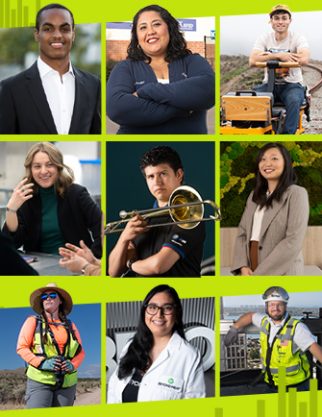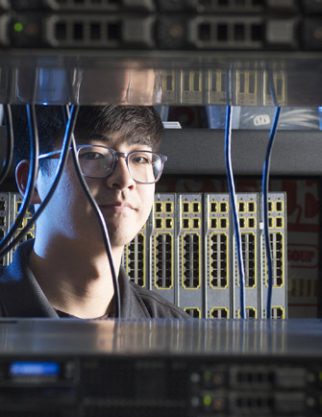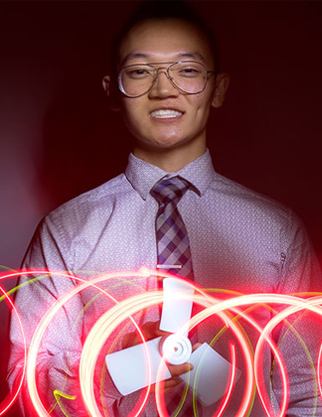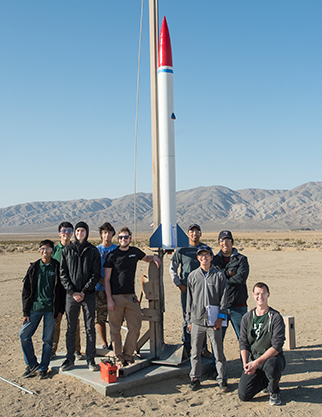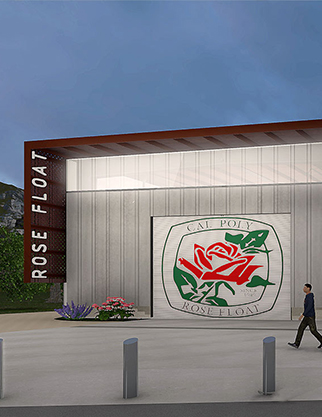Bronco’s Best
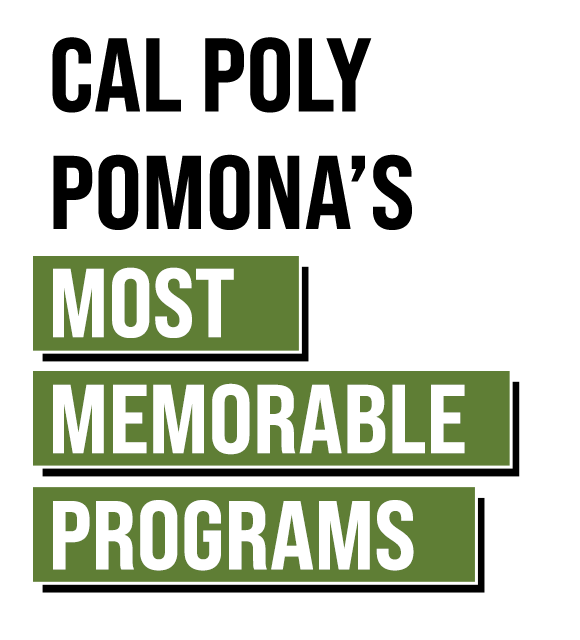
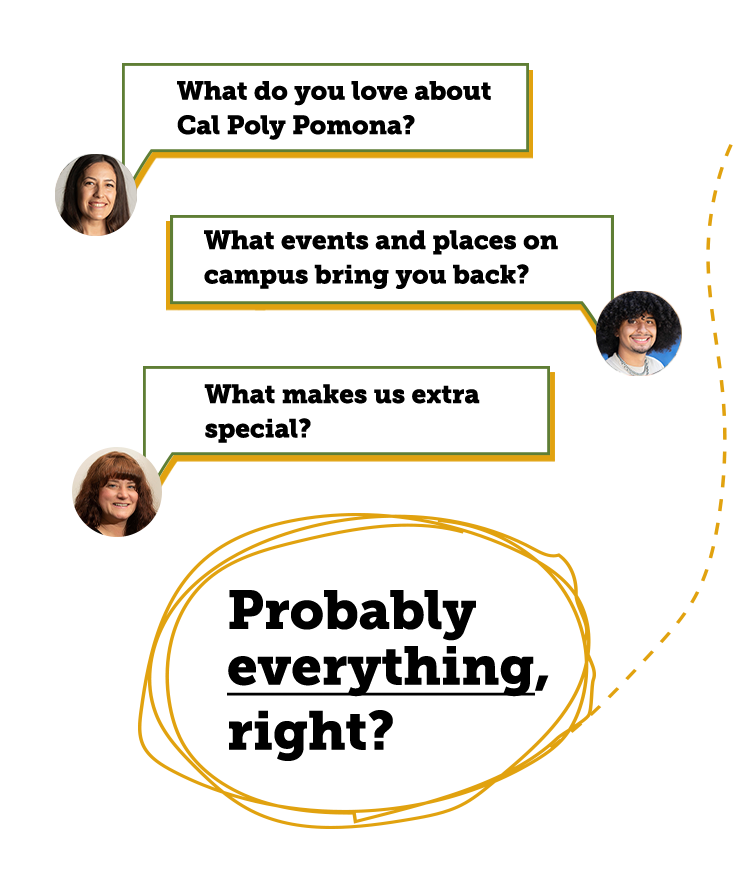

Cal Poly Pomona has so much to offer — Arabian horses, rocket launches and a mariachi band. You can’t find this unique combination at any other university in the world. All these experiences and more make Cal Poly Pomona extraordinary.
We knew it would be impossible to create just one list highlighting the best of Cal Poly Pomona, because there are so. many. things. But we tried anyway. Here’s our Top 10 Bronco’s Best That Everyone Should Know About.



1. Floating on Awards
Few could have predicted when the very first Cal Poly Universities’ Rose Float made its way down Colorado Boulevard on New Year’s Day 1949 that it would be the start of Cal Poly Pomona and Cal Poly SLO’s impressive run of 73 parade entries — one of the longest, consecutive, self-built entries in the Rose Parade and the only perennial float designed and constructed by students.
What started with a budget of $248 and a handful of students blossomed into a robust program winning 60 awards or trophies over the past 73 years with nearly 200 students, alumni and community members volunteering to build the annual float. Students learn varied skills from welding and creating animated objects, to collaboration and leadership – abilities they learn very quickly to produce a visual and mobile piece of art.
The program recently celebrated the opening of a new Rose Float Lab and Design Complex, which includes 14,000 square feet of indoor and outdoor space. The $5.5 million lab came to fruition through the generous support of our alumni and community members, giving Rose Float students the space to continue the legacy of building innovative and beautiful floats.
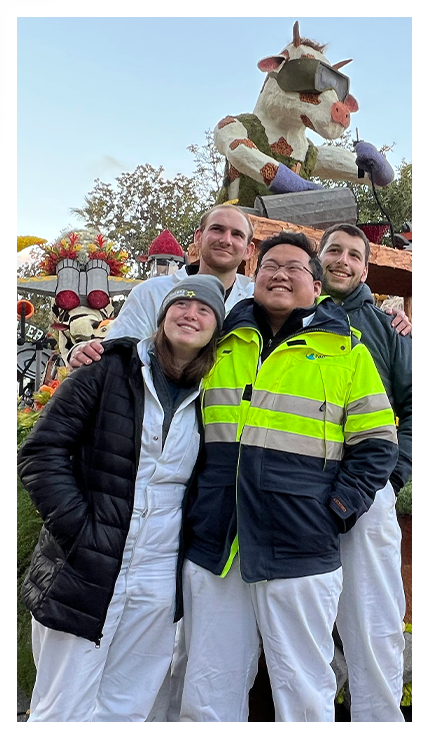
Students learn skills like welding and creating animated objects, to collaboration and leadership – abilities they learn very quickly to produce a visual and mobile piece of art.
Planning is already underway for the 2023 float as our students work year-round to design and build the next award-winning float. Catch their newest creation every New Year’s Day.

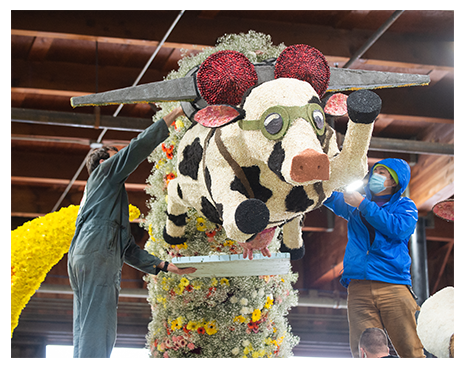
2. Kellogg’s Original
If you toured the W.K. Arabian Horse Center today, you would see students working as stall cleaners and groomers, and living at the facility to provide daily feeding and essential care of the Arabian herd. Another group of students enrolled in the Foal Watch Class (open to all majors), offered through the Department of Animal and Veterinary Sciences, are involved with the birth of new Arabians. On average, 10 purebred Arabian foals are born each spring, and currently 70 Arabians call Cal Poly Pomona home.
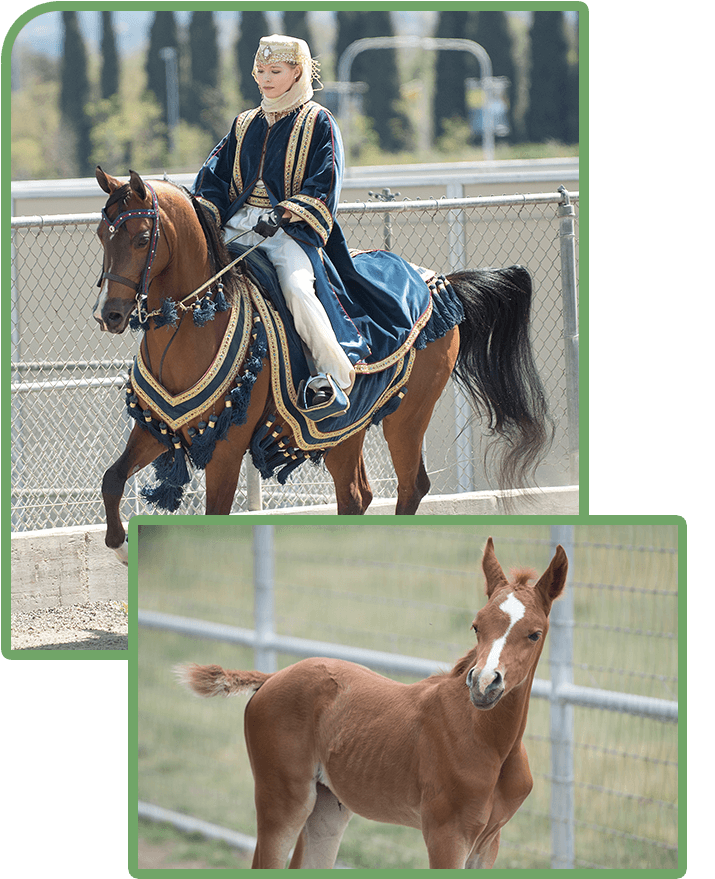
Long before our campus became a university, cereal magnate W.K. Kellogg began a breeding program for Arabian horses in 1925, bringing the finest examples of the breed from across the globe. The ranch, which was his winter home, became a popular tourist attraction, and Kellogg hosted a horse show on Sundays to showcase his prized Arabian horses.
Today, the Arabians continue to thrive, and many can trace their lineage back to Kellogg’s original horses.
Kellogg offered the ranch to the state in 1932 with the stipulation that the breeding program and Sunday shows would continue in perpetuity. After a brief stint as a U.S. Army facility for breeding war horses, the ranch was turned over to California State Polytechnic College San Luis Obispo as their southern branch in 1949.
Students not only directly work and help raise these historical horses, but the horses also work with the students. Students from the Veterans Resource Center and Womxn’s Resource Center worked with the Arabians through therapeutic programs, and students from the Don B. Huntley College of Agriculture can conduct research to contribute to the equine field.

3. Control + Alt + Delete
“Are you a robot? Select all fire hydrants.”
“We’re sorry to inform you that your private information may have been compromised.”
Welcome to the world of cyber security, where users must access webpages by entering 6-digit security codes to prevent hackers from stealing credit card numbers.
It’s an industry that Cal Poly Pomona students can say, “We beat Stanford!” in an international competition, claiming the No. 1 in the world.

Writing and reading computer code is a unique skill, like learning self-defense in another language, only armed with a computer screen and keyboard to block people from stealing anything available in the digital realm. Cyber students have the advantage of the university’s Cyber Collaborative, a partnership among the colleges of Business Administration, Engineering, and Science to advance technologies and discover new ideas. In computer network simulations, students can hack into any network — an ATM, payment processing applications, webpages — and develop preventative safety measures.

Students also participate in community service. From mentoring middle and high school students to sharing security tips during the annual Cyber Security Awareness Fair, the next generation of cyber security pros teach community members how to recognize fake webpages that might steal private information and how to protect their home Wi-Fi networks.
And when students graduate, they are ready to take on the cyber world, earning internships and full-time positions in companies, organizations and government agencies, including the Jet Propulsion Laboratory, U.S. Navy, Northrop Grumman and Microsoft. As long as the cyber world exists, Cal Poly Pomona students and alumni are here to help keep the digital world safe.
4. Pomona, We Are Go For Launch
Cal Poly Pomona’s aerospace engineering students are on a mission to become the first university to launch a liquid-fueled rocket into space, and they are one step closer with newly opened lab in April that will aid students in their pioneering journey.
“The Liquid Rocket Lab (LRL) offers our students a totally unique hands-on experience working on real world projects that prepare them to solve these complex problems that exist in the aerospace industry,” says Frank Chandler, associate professor of aerospace propulsion and the LRL director. “When an employer sees that a student has been doing practical work in the Liquid Rocket Lab and find out what all they do, the students get hired almost directly.”
“The hands-on experience I’ve gained through this project has directly prepared me in securing this dream career. I think the Liquid Rocket Lab project is the absolute embodiment of the learn-by-doing philosophy, and I’m so grateful for my time here,” says Melody Neu, president of the LRL club.
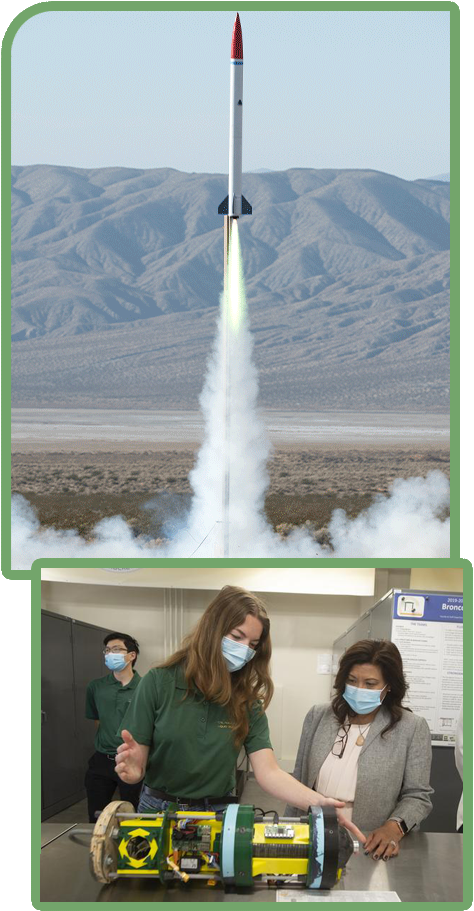
The 2,100-square-foot facility includes computers, a 3-D printer, equipment and workstations — all dedicated to designing and building a rocket that can achieve an altitude of 45,000 feet.
The lab received a $1.67 million founding gift from the National College Resources Foundation, which focuses on increasing higher education opportunities and success for underserved and underrepresented students. The federal government provided subsequent funding, thanks to the efforts of U.S. Congresswomen Norma Torres and Grace Napolitano, who helped secure an Educational Partnership Agreement between Cal Poly Pomona and Cal Poly San Luis Obispo and the Air Force Research Labs. The two universities split $25 million over four years, with Cal Poly Pomona using its half for the rocket lab. Other donors have stepped up to help, including Boeing.
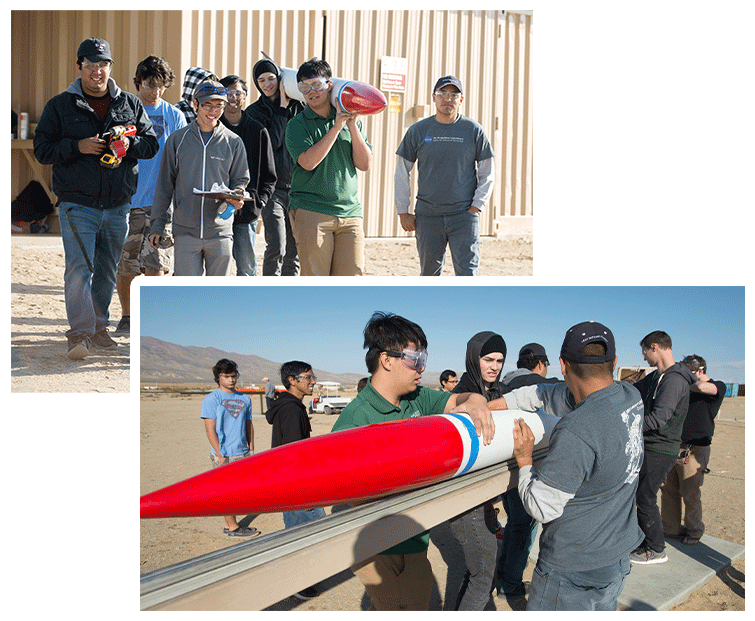
5. Easy as 1, 2, 3
Call it the A, B, Cs of nurturing and supporting future teachers — Advocate, Bolster and Champion.Since 2006, Partners in Education (PIE) has been following that lesson plan to the letter. Each year, the coalition of academic and community leaders provide $4,000 to students starting their in-classroom clinical experience that is required for their credential. The PIE board — which consists of Cal Poly Pomona alumni, faculty and staff, businesses, local organizations and university friends — sponsors the fellowships.
The group has awarded more than 250 fellowships, totaling over $1 million, to students pursuing their teaching credentials through the College of Education and Integrative Studies.

Teacher candidates must complete an online application and participate in a panel interview with the PIE board of directors to be eligible for a fellowship.
PIE, which celebrated its 15th anniversary in 2021, was created in response to the ongoing teacher shortage in California driven by a decline in the number of people seeking teaching credentials and the imminent retirements of veteran educators.
PIE has supported many other projects, including a partnership between the Pomona Public Library and the university’s Service Learning Center, offered through the university’s Center for Community Engagement, for a homework center at the library for K-12 students, the annual credential celebration event, and formation of an alumni group that includes hosting professional development workshops for K-12 teachers.
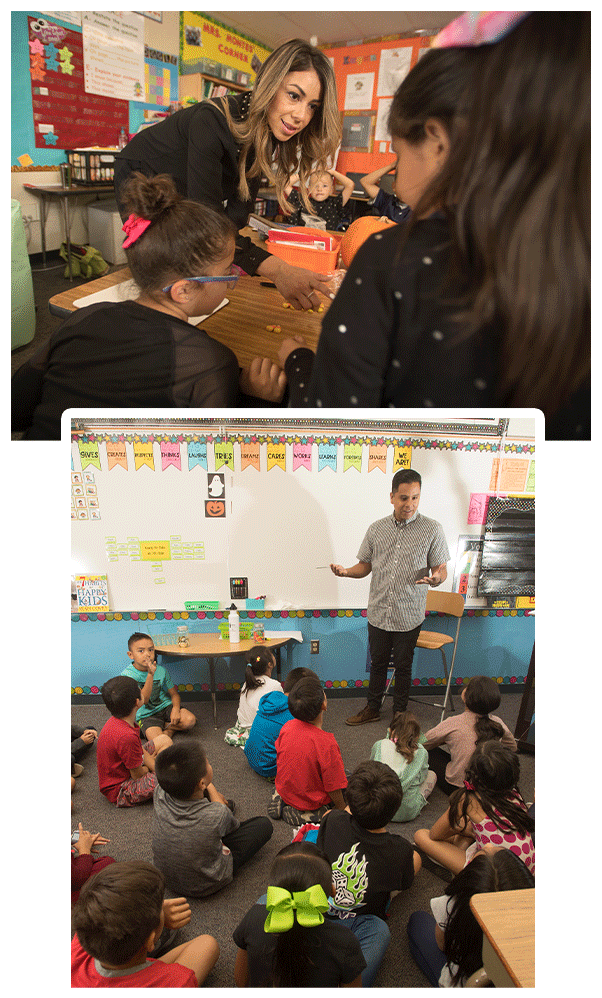
6. The Future of Food
Cal Poly Pomona food science and technology students have fun combining food and science, taking on a role of mad scientists in their white lab coats in search for sustainable food products.
What food products have they been testing? They used a rice-like product made from “insect flour” — dried, ground-up insects — to see if consumers would eat a high-protein food source that is more economically and environmentally friendly to produce.
We’re making pasta out of fava beans and peas for consumers with celiac disease.

They repurposed unused food into ingredients for new products and used old ingredients in innovative ways to address consumer needs, like making pasta out of fava beans and peas for consumers with celiac disease who are unable to eat traditional pasta.
These product ideas have the potential to move from the lab to grocery store shelves. Students have taken their creations to intercollegiate competitions and taking first in American Society of Baking and Research Chefs Association product development competitions, beating out teams from larger schools such as the University of Wisconsin, University of Florida and Purdue University. They continue to test their out-of-the-cage ideas in graduate school and the food industry at companies such as Bimbo Bakeries, Beyond Meat and Target.
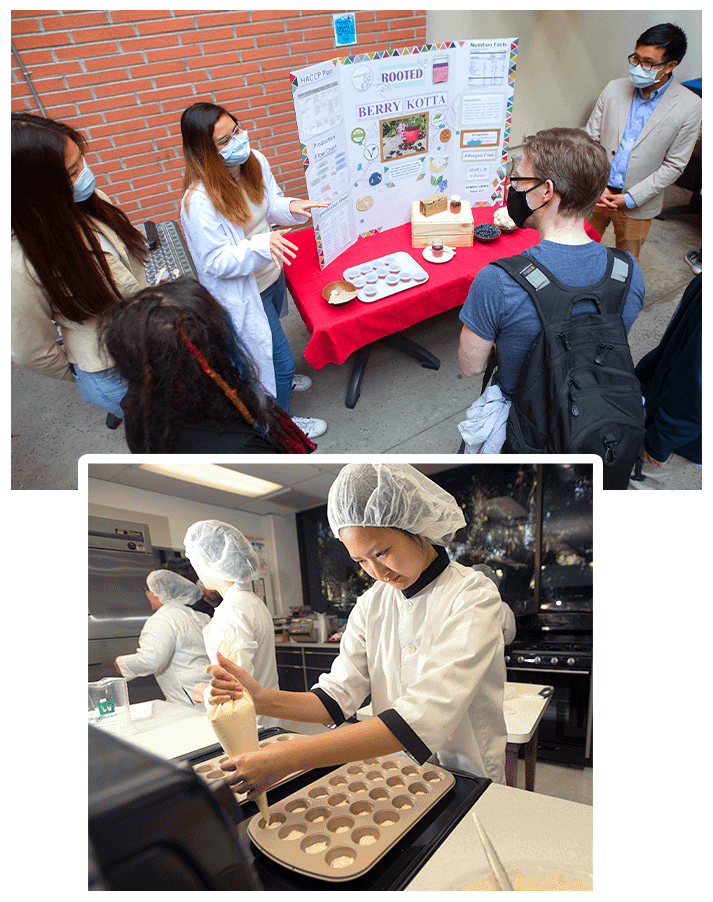
7. Learn by Brewing
Across from the athletic fields and the Farm Store, giant metal vats with a yellow and black logo reading, “Innovation Brew Works,” sit on a corner off Temple Avenue. Cal Poly Pomona has its own award-winning microbrewery and restaurant that also serves as a lab for students to learn the science behind crafting the frothy beverage.
Eric Bassett, the brewery operations manager, says there are five main ingredients to beer: yeast, water, hops, barley and gas. In collaboration with the university’s agricultural programs, the brewery uses barley grown at Spadra Ranch, citrus notes from the university’s orange groves, strawberries from AGRIscapes to brew the Berries and Cream Ale, and even a white wine barrel that previously fermented grapes for Cal Poly Pomona’s zinfandel wines to produce Brew Works’ aged Saison beer named Report Card.
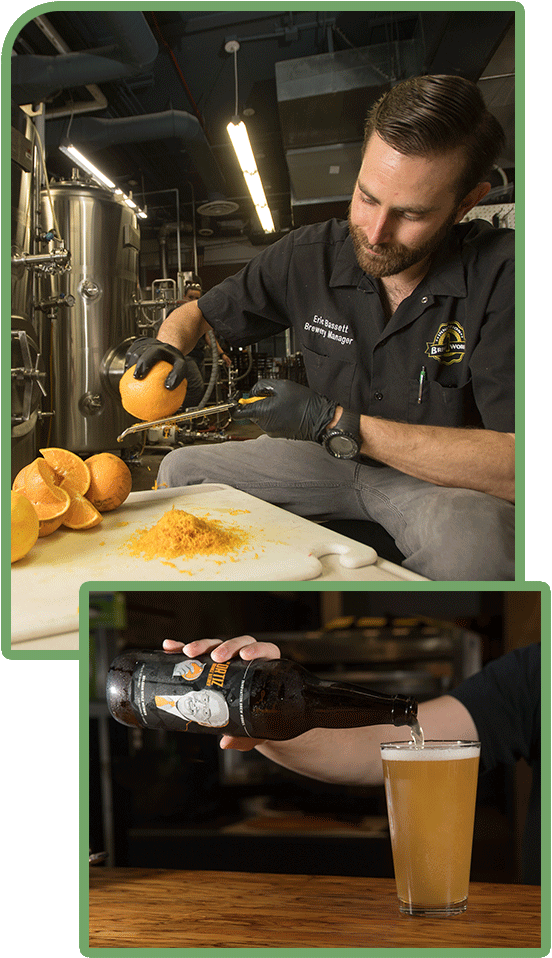
After the grain and barley have been used for beer production, it is repurposed to feed the livestock on campus.
In 2020, the Collins Cream Ale was named after philanthropist Jim Collins, namesake of The Collins College of Hospitality Management. The ale features vanilla notes because it was one of Collins’ favorite flavors. You can find familiar faces on the beer labels, including former President Michael Ortiz on his very own Dr. Ortiz Orange Witbier, which draws upon the campus-grown citrus.
You can find Innovation Brew Works beer at retailers in Claremont, Pomona and La Verne, or head directly to the brewery on campus. Cheers and drink responsibly!
The brewery features beers that honor prominent individuals with ties to Cal Poly Pomona.
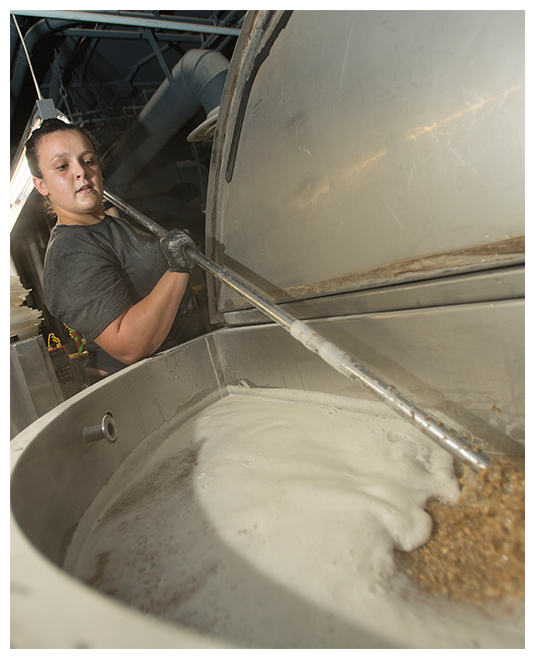
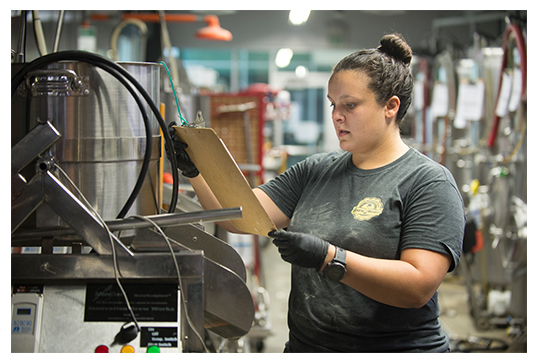
8. Gourd Vibes Only
It began nearly 30 years ago as a simple, humble patch along Temple Avenue.
Today, it’s the largest event at Cal Poly Pomona, drawing more than 75,000 visitors from across Southern California throughout October.
The Pumpkin Fest is an annual fall tradition for families to explore the corn maze, pet farm animals, go on hayrides, and, of course, pick a pumpkin grown and harvested by Cal Poly Pomona students. The event features contests for all generations, ranging from Halloween costumes to pumpkin pie eating to seed spitting.
The festival and field trips employ many students. The jobs give them hands-on work experience, and the event proceeds support farm operations, student club activities, and agricultural education trips and opportunities.

The Pumpkin Fest has also evolved into a celebration of California agriculture where visitors can learn about Cal Poly Pomona’s farming heritage. Sheep shearing and cow milking are among the demonstrations and exhibits at the event’s Ag Discovery Lane. The university’s AGRIscapes Center has long hosted the event. Dozens of local schools come for field trips to the pumpkin patch. For many schoolchildren, the visit is their introduction to farming, the Huntley College of Agriculture and Cal Poly Pomona.
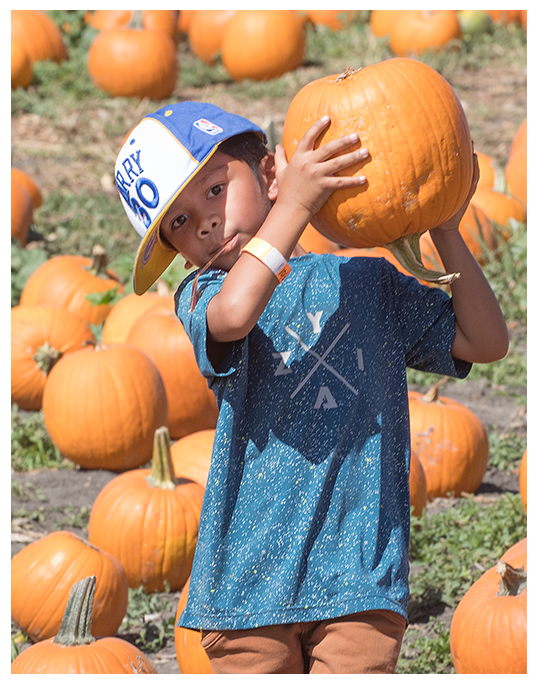

9. Designing for Good
There’s a saying that good design is invisible.
The influence of alumni of Cal Poly Pomona’s architecture and landscape architecture programs is neither unseen nor unfelt. They produced two Walt Disney Imagineering presidents, Bob Weis (’80, architecture) and Barbara Bouza (’85, architecture), and the only landscape architect, Don Brinkerhoff (’52, ornamental horticulture), inducted to the American Gaming Association’s Hall of Fame for transforming the famed Las Vegas Strip as we know it today.
Yet there’s more to design than the theatricality of escapism. These two nationally celebrated programs train emerging professionals to take on climate change and sustainability, equity and education, and housing and urban design. They draw hundreds of recruiters to the annual Firm Day jobs fair to find the perfect addition to their firms.
These two disciplines also have the power to do good.
The programs train emerging professionals to take on climate change and sustainability, equity and education, and housing and urban design.
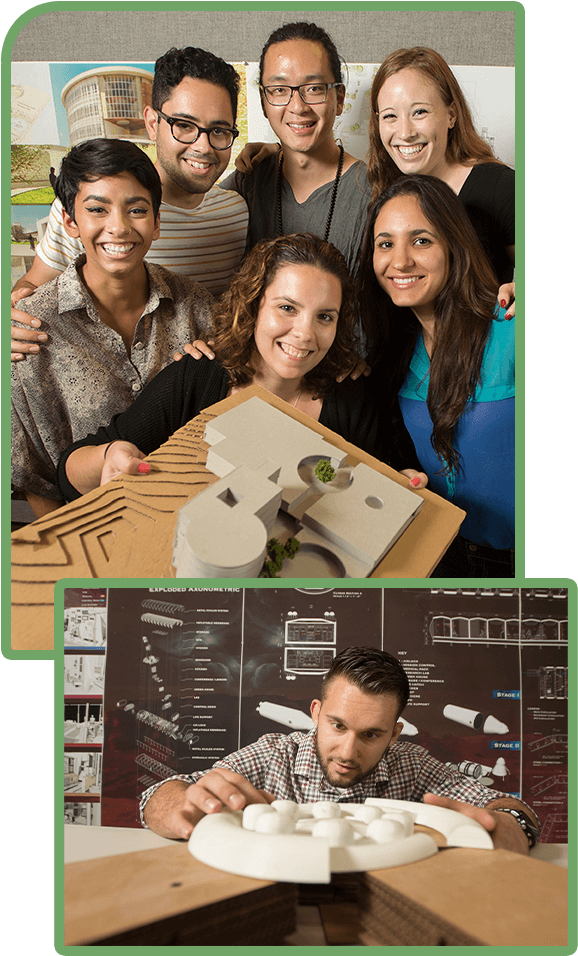
Scott Martin’s (’02, landscape architecture) work in peace building and conflict resolution in Thailand was recognized with Rotary International’s Peace Fellow Award. Pamela Conrad (’06, master’s in landscape architecture), principal at CMG, developed Climate Positive Design, a carbon calculation tool measuring the environmental impact of projects.
And at the height of the pandemic, Assistant Professor Claire Latané led the National COVID-19 Outdoor Learning Initiative’s Emergency Schoolyard Design Volunteers. The pro bono landscape design assistance program matched schools with design firms, individual practitioners, and students to transform campus outdoor spaces into safe, learning environments. CPP students and alumni were among more than 250 volunteers that advised participating schools.
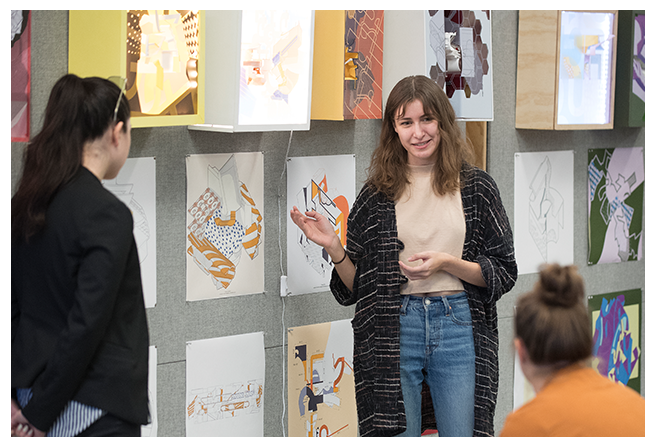

10. Let’s Go Broncos, Let’s Go!
Cal Poly Pomona is home to 11 intercollegiate athletics teams that compete at the NCAA Division II level, and they provide the campus community with championship-caliber entertainment from August to May.
As a team, the university has celebrated 15 NCAA Division II National Championship titles, most recently the men’s basketball team in 2010. Along with having star teams, Cal Poly Pomona has star student athletes as well.
Student-athletes have captured 33 conference Player of the Week awards across all sports in 2021-22.
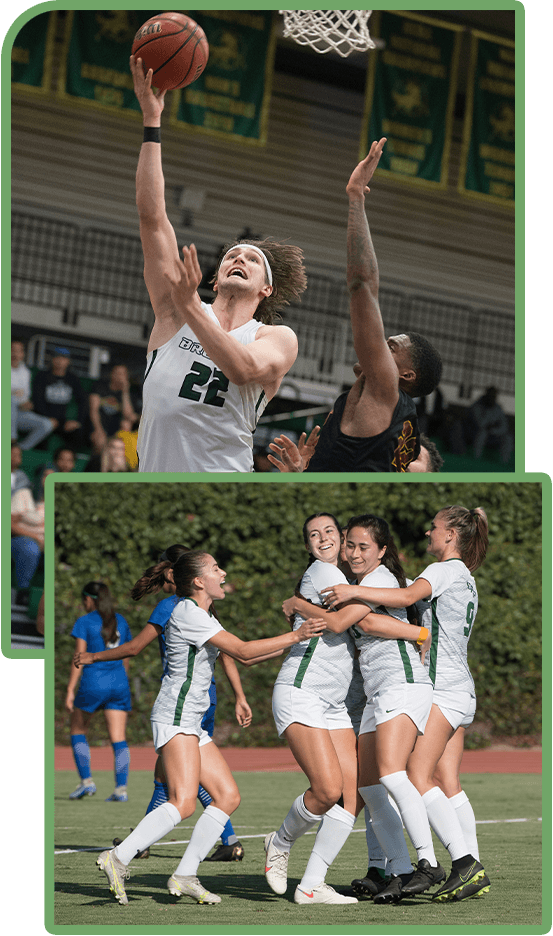
Ayana Fields (’22, kinesiology) and her twin brother, Ryan (’22, computer information systems) are two examples of the best of the best. They are among the nation’s fastest in NCAA Division II track and field, Ayana earning five All-American awards and a two-time All-American this indoor season, and Ryan, who competed at the junior championships and finished third in the nation in 2019. Both are continuing their education at the university to earn master’s degrees: Ayana, an aspiring physical therapist, will pursue a graduate degree in exercise physiology and Ryan plans to pursue a master’s degree in information security.
“They are great leaders, but they are so much beyond just being really great athletes,” says Chris Bradford, track and field head coach. “They are really great people to be around, and they are so happy to be a part of the CPP community.”
All 11 Bronco teams have competed in the NCAA Championships at least once in the last few years, including the men’s soccer team which has captured the West Region title three times in the past six seasons. Men’s soccer, women’s volleyball, men’s and women’s cross country, men’s basketball, and women’s indoor track and field, baseball, and men’s and women’s outdoor track and field have all competed in NCAA postseason events this year.
For all current CPP students, staff and faculty, hundreds of Broncos home games are free to attend each year.
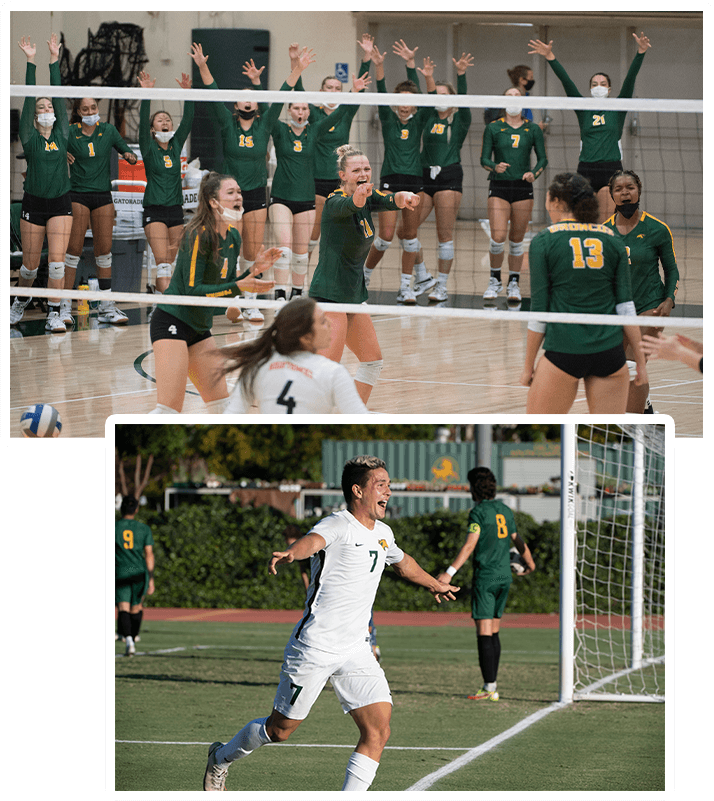
Thanks for visiting
Top 10 Bronco’s Best
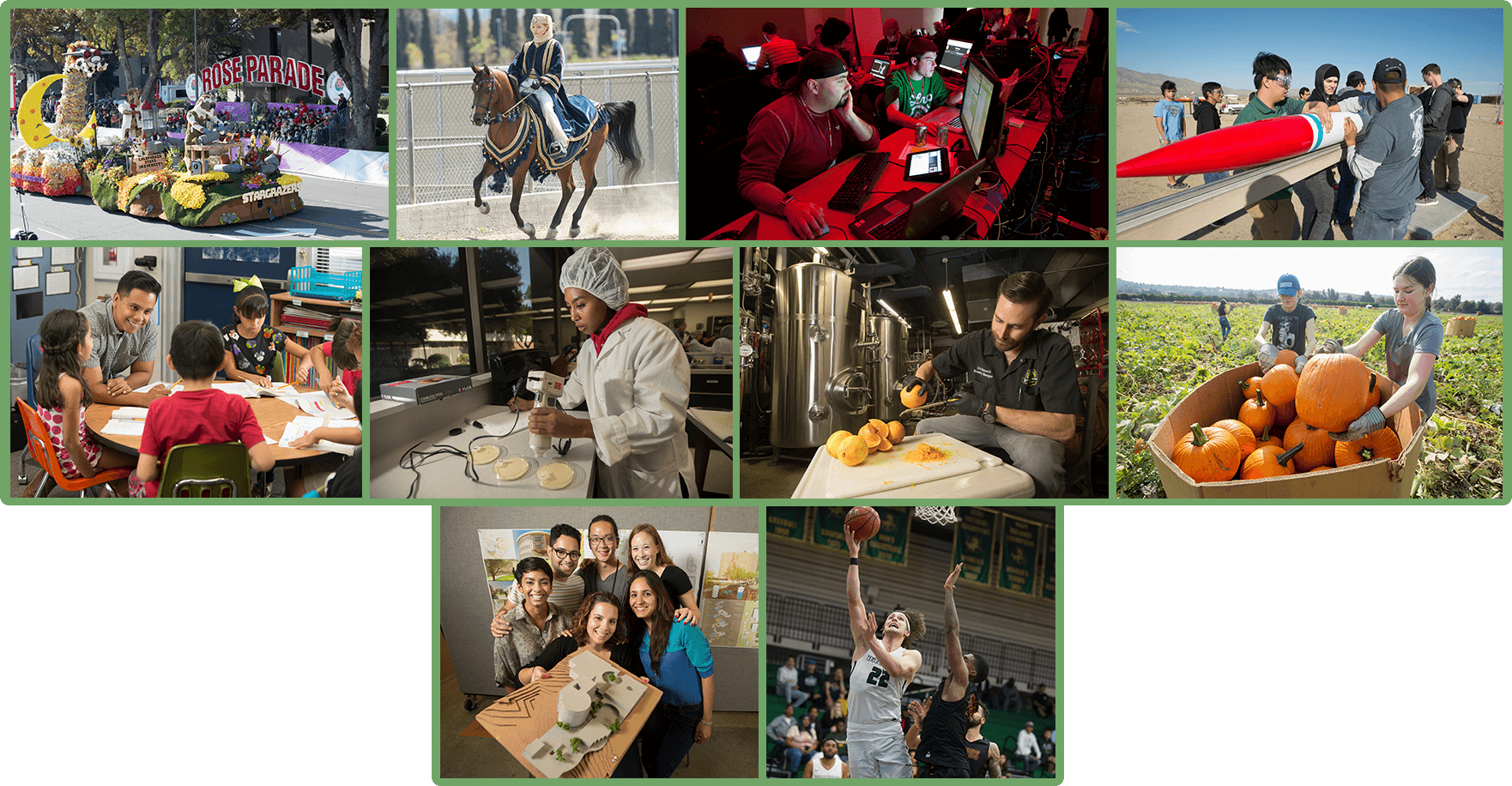
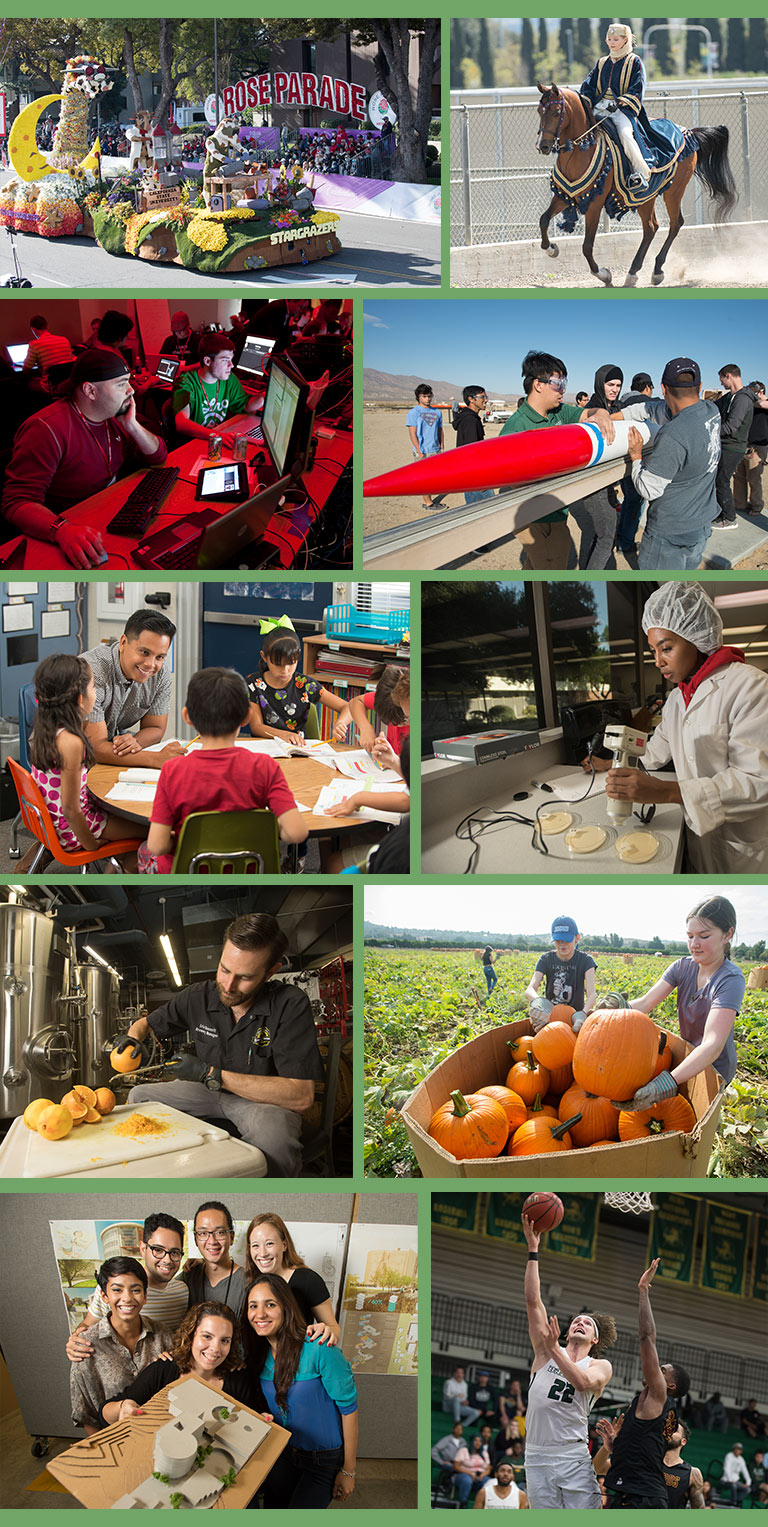
Contributors:
Rylan Braley, Samantha Gonzaga, Melanie Johnson, Dan Lee, Tyler Lobe, Michelle Magcalas, Esther Chou Tanaka, Tom Zasadzinski, Lindsey Bistline Zavala
